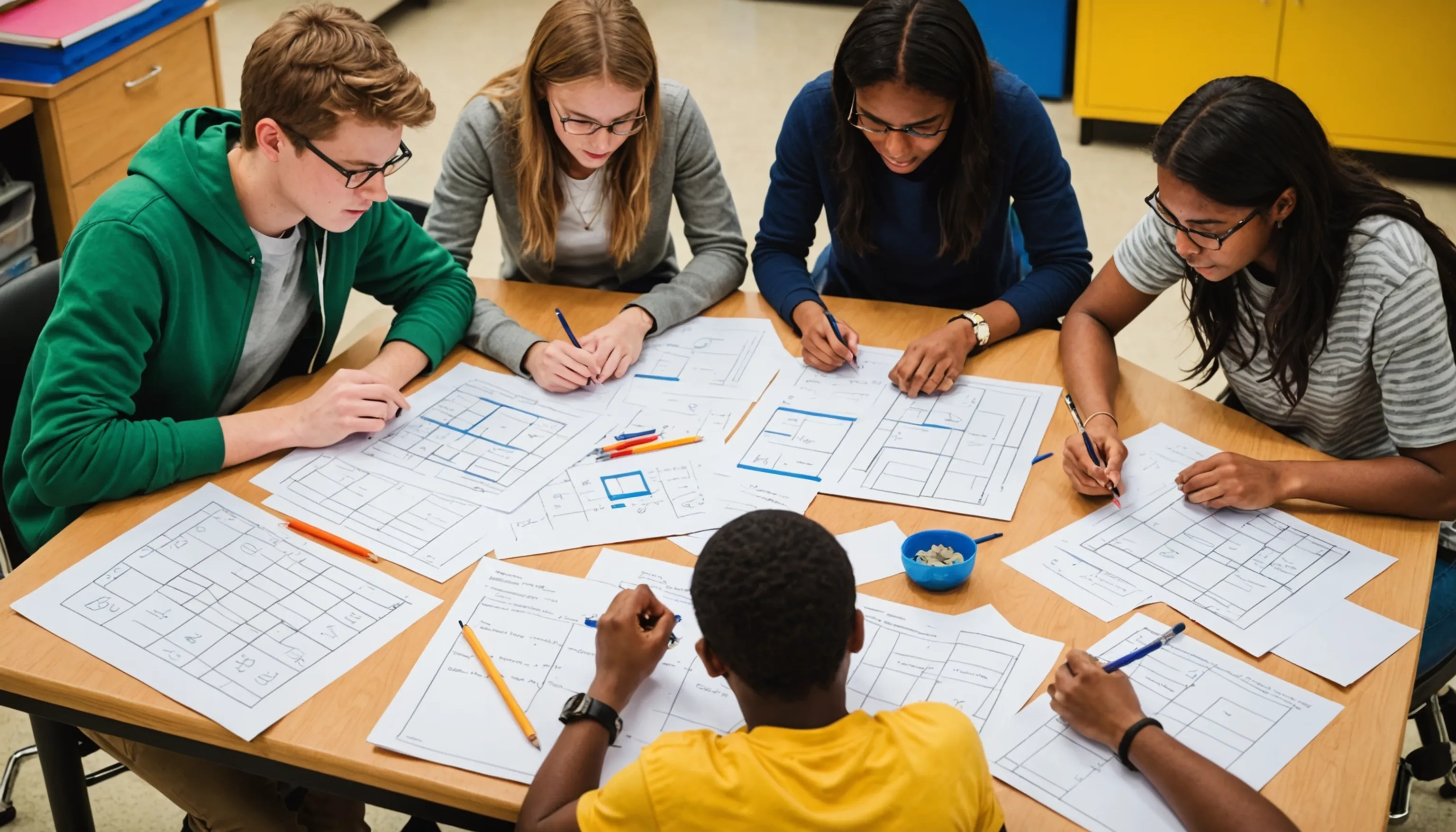How to Make Math Learning Fun for You
 HvWHenry van Wagenberg
HvWHenry van Wagenberg
Making Math Learning Fun for Teenagers
Making math learning fun for teenagers is essential to engage them and enhance their understanding. One effective approach is to incorporate games into lessons. Games can transform boring math concepts into exciting challenges that motivate students to participate. For example, using math-related board games or online quizzes can stimulate interest and foster friendly competition.
Additionally, relating math to real-world scenarios helps teenagers see its value. Discussing how math applies to finance, sports, or technology can make the subject more relevant. Creating a positive learning environment where students feel comfortable asking questions is crucial for their growth.
Incorporate Games into Math Learning
Incorporating games into math learning is a fantastic way to engage teenagers and make the subject enjoyable. Games can transform traditional lessons into interactive experiences, promoting collaboration and critical thinking among students. Here are some effective strategies to integrate games into math education:
- Board Games: Classic board games like Monopoly can teach concepts such as money management, addition, and subtraction. You can also create custom board games focused on specific math skills.
- Online Math Games: There are numerous websites and apps that offer interactive math games tailored for teenagers. Websites like Kahoot! and Prodigy provide a fun way to practice math skills through quizzes and challenges.
- Card Games: Simple card games can reinforce math concepts. For instance, games like 21 or Set require players to use addition, subtraction, or pattern recognition.
Additionally, incorporating competitive elements can motivate students. Organizing math competitions or challenges can foster teamwork and encourage students to improve their skills in a fun setting.
Remember to keep the atmosphere light-hearted and supportive. Celebrate victories, no matter how small, and encourage students to learn from mistakes. By integrating games into math learning, you can create an engaging and positive environment that promotes a lifelong love for math.

Use Real-World Applications of Math
Using real-world applications of math is an effective strategy to engage teenagers and demonstrate the subject's relevance in everyday life. By connecting mathematical concepts to practical situations, students can better understand the value of math and how it impacts their daily decisions. Here are several ways to incorporate real-world applications into math learning:
- Finance: Teach students about budgeting, saving, and investing. Create scenarios where they must manage a budget for a project, plan a trip, or calculate interest on savings. This helps them grasp the importance of math in managing personal finances.
- Cooking and Baking: Use recipes to explore measurements, conversions, and proportions. Students can practice fractions by adjusting recipe quantities, fostering a hands-on approach to learning.
- Sports Statistics: Analyze player statistics, scores, and averages in their favorite sports. This real-world context makes math engaging and relatable, especially for sports enthusiasts.
Additionally, incorporating projects that require math applications can enhance learning. For instance, students can design a small business plan, calculating costs, profits, and pricing strategies. This not only reinforces math skills but also encourages critical thinking and creativity.
By consistently highlighting how math is utilized in various fields and everyday activities, teenagers can develop a deeper appreciation for the subject. Understanding that math is not just abstract but a practical tool for solving real problems will motivate them to engage more fully in their math education.
Create a Positive Learning Environment
Creating a positive learning environment is crucial for making math enjoyable and effective for teenagers. Start by fostering a culture of respect and encouragement in the classroom. Encourage students to voice their opinions and ask questions without fear of judgment. Use positive reinforcement to celebrate their efforts and achievements, no matter how small. Arrange the seating to promote collaboration and interaction among students. Additionally, incorporate a variety of teaching methods to cater to different learning styles, ensuring that each student feels included. A supportive atmosphere will motivate teenagers to engage more actively with math concepts.

Encourage Group Study Sessions
Encouraging group study sessions is an effective way to make math learning more enjoyable and productive for teenagers. Group study not only fosters collaboration but also enhances understanding as students can share different perspectives and approaches to solving problems. Here are several strategies to facilitate effective group study sessions:
- Organize Study Groups: Create study groups with a mix of skill levels to promote peer learning. Stronger students can help their peers, reinforcing their own knowledge while boosting confidence in others.
- Set Clear Goals: Before each session, establish specific objectives. This could include mastering a particular concept, completing homework assignments, or preparing for an upcoming test. Clear goals help keep the group focused and motivated.
- Use Interactive Activities: Incorporate games, quizzes, or challenges into study sessions. These activities can make learning fun and encourage friendly competition, enhancing engagement.
- Rotate Roles: Assign different roles within the group, such as facilitator, note-taker, or quizmaster. Rotating these roles can help students develop various skills and keep everyone involved.
Additionally, encourage students to discuss their thought processes and reasoning aloud. This practice helps clarify concepts and reinforces learning. Emphasize the importance of respect and support within the group, ensuring all members feel valued.
By fostering group study sessions, you can create a sense of community among students, making math a more enjoyable and collaborative experience.
Provide Rewards for Achievements
Providing rewards for achievements is a powerful motivator that can significantly enhance teenagers' engagement in math learning. Recognizing and celebrating accomplishments, whether big or small, fosters a positive attitude toward learning and encourages students to strive for excellence. Here are some effective strategies to implement a reward system in your math classes:
- Set Clear Milestones: Define specific goals or milestones for students to achieve, such as mastering a particular math concept, completing a challenging assignment, or improving test scores. This clarity allows students to focus their efforts and understand what they’re working toward.
- Offer Tangible Rewards: Rewards can take many forms, including stickers, certificates, or even small prizes like gift cards. Consider giving out rewards for individual achievements, group successes, or consistent effort over time.
- Incorporate Fun Activities: Organize special events or activities as rewards for collective achievements. For example, if the class collectively meets a goal, plan a game day or a math-themed party. This not only reinforces teamwork but also makes learning enjoyable.
- Recognize Effort and Improvement: While high scores are important, recognizing effort and improvement is equally crucial. Celebrate students who show significant progress, regardless of their starting point. This approach helps build confidence and encourages a growth mindset.
By implementing a reward system, you can create a motivating environment that inspires teenagers to actively engage with math, reinforcing their belief that hard work and persistence lead to success.
Utilize Technology and Apps for Learning
Utilizing technology and apps for learning can significantly enhance teenagers' engagement with math. There are numerous educational tools available that make math practice interactive and enjoyable. For instance, apps like Photomath allow students to scan problems and receive step-by-step solutions, promoting self-guided learning.
Additionally, platforms like Khan Academy offer a wealth of resources, including instructional videos and practice exercises tailored to various skill levels. Incorporating these technologies into lessons encourages students to take ownership of their learning, making math more accessible and relevant in today’s digital age.
Math Learning Apps and Resources
Math learning apps and resources are essential tools that can make math more accessible and enjoyable for teenagers. With the right applications, students can practice math concepts at their own pace, reinforcing their understanding through interactive activities. Here are some of the top math learning apps and resources that can enhance the educational experience:
- Khan Academy: This free platform provides a comprehensive library of instructional videos and practice exercises across various math topics. Students can learn at their own pace while tracking their progress.
- Photomath: An innovative app that allows students to take pictures of handwritten or printed math problems. It then provides step-by-step solutions, helping students understand the process behind the answers.
- Prodigy: A game-based learning platform that makes math fun. Students engage in math challenges while exploring a fantasy world, promoting motivation and healthy competition.
- IXL: This personalized learning platform offers interactive questions tailored to the student's skill level. It provides immediate feedback, allowing students to learn from their mistakes.
Additionally, online resources such as Mathway and Desmos offer tools for solving problems and visualizing equations, respectively. These resources encourage students to explore math concepts beyond traditional classroom settings.
By integrating math learning apps and resources into their study routines, teenagers can build confidence and develop a deeper understanding of mathematical principles, making the learning experience more engaging and effective.
Interactive Math Websites
Interactive math websites are invaluable resources that can significantly enhance teenagers' understanding and enjoyment of math. These platforms provide engaging content, interactive exercises, and instant feedback, making math learning dynamic and effective. Here are some top interactive math websites that can benefit students:
- Math Playground: This site offers a variety of math games, puzzles, and problem-solving activities tailored for different grade levels. It covers topics such as addition, subtraction, fractions, and geometry, allowing students to practice their skills in a fun way.
- IXL: IXL provides personalized learning experiences with over 8,000 skills across various math topics. Students receive immediate feedback on their answers, helping them identify areas for improvement while tracking their progress over time.
- Prodigy Math: Prodigy combines gaming with math practice, allowing students to embark on adventures while solving math problems. This platform engages students through a fantasy-based environment, making practice enjoyable and motivating.
- Khan Academy: This comprehensive resource offers a wealth of instructional videos, practice exercises, and quizzes in a user-friendly format. Students can learn at their own pace, revisiting concepts as needed.
Furthermore, websites like GeoGebra allow students to visualize mathematical concepts through interactive graphs and geometry tools, enhancing their understanding of complex topics.
By utilizing these interactive math websites, teenagers can cultivate a more positive attitude toward math, developing their skills through engaging and effective methods.
